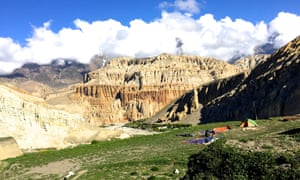As a resident of Kathmandu, I picked a good week to go running in the mountains. On the 20 April, along with 25 other enthusiasts from across the world, I headed to Jomsom (not a journey for nervous flyers) to start the eight-stage Upper Mustang Trail Race. Now in its fourth year, the race is famous for its spectacular landscapes, brutal ascents and remoteness. A few days from the start, that remoteness would become both a blessing and a curse.
The first three stages of the race took us through ancient Buddhist villages, over 4,000-metre passes and across precarious foot bridges to the region’s capital of Lo Manthang. Under normal circumstances, I would go on to describe the beautiful scenery in more detail but, midway through the fourth stage, the 7.9 magnitude earthquake struck.
We were roughly 200km from the epicentre, and the effects were clearly visible – with a number of walls crumbling and rocks tumbling down mountain sides – but it was far less dramatic than on the southern side of the Himalayas. Walking through the village that afternoon in search of means of communication, people either asked us whether it had also occurred in Europe or confidently told us that there would be another one at various specific times.
Our first instinct was to return to Kathmandu as quickly as possible, where we had friends, colleagues and homes to check up on. However, being three days walking and two flights away, and with transport services severely disrupted, this was far from straightforward. In fact, given that we were at the furthest point on our loop, the quickest way back was, oddly, to carry on running.
The next three days were spent chasing speedy Nepali runners (in particular the ex-military dynamo Bhim Gurung and the rising star of women’s trail running Mira Rai) across the trails of Mustang, circumnavigating landslides along the way. It was a surreal feeling to be continuing the race without knowing what sort of a home we were returning to.
Eventually we made it back to Jomsom and were able to catch flights for Pokhara and onward to Kathmandu. The plane’s-eye view revealed a landscape dotted with orange tarpaulins. Returning to Kathmandu was a strange experience: on the one hand, many parts of the city had normalised and the destruction was much less than it could have been; on the other hand, the collective fear was palpable, with many still sleeping outside by choice. Hundreds of thousands of people had left the city altogether, leaving an eerily deserted atmosphere.
The one thing Kathmandu has not been short of since the first quake is a well-intentioned desire to help, with hundreds of foreigners flying in to assist. But the reality is that, in most cases, it isn’t direct involvement that is needed – it’s money. And beyond the cash donations (to well-researched organisations, of course) to help with the relief effort, the main area where Nepal will need assistance is economic recovery.

Given that Nepal relies on tourism for 10% of its GDP and roughly half a million jobs, if you really want to help, then plan a holiday there. I have only just begun to discover this country, from the exquisite beauty of Annapurna base camp at sunrise, to the marvels of the countless stupas and temples (not all of which have fallen down), and the slightly too-adrenaline-filled excitement of walking safaris in Chitwan national park. By visiting, you will be helping rebuild the country.
And for those who see running and holidays as a natural combination, then Nepal truly is an unbeatable destination. The country has tens of thousands of miles of trails ranging from the easily accessible to the challengingly remote. Some undulate gently, allowing for smooth and fluid progress; while others consist of nothing but seemingly unrunnable ascents and unwalkable descents. On the many high-altitude plateaus, you can develop a whole new appreciation of oxygen while sucking in air like a Dyson. Imposing, picturesque 8,000-metre peaks loiter on every horizon. At each village, you are greeted by friendly, amused and perplexed locals offering sweet tea, Gorkha beer and their famous dahl bhat and momo dumplings. And when you begin to tire, you can always watch the amazing Nepali runners who make it look effortlessly easy. It’s little wonder that elite runners, such as Lizzy Hawker and Kilian Jornet, have developed such a fondness for this runner’s paradise.
Source: Read Full Article
